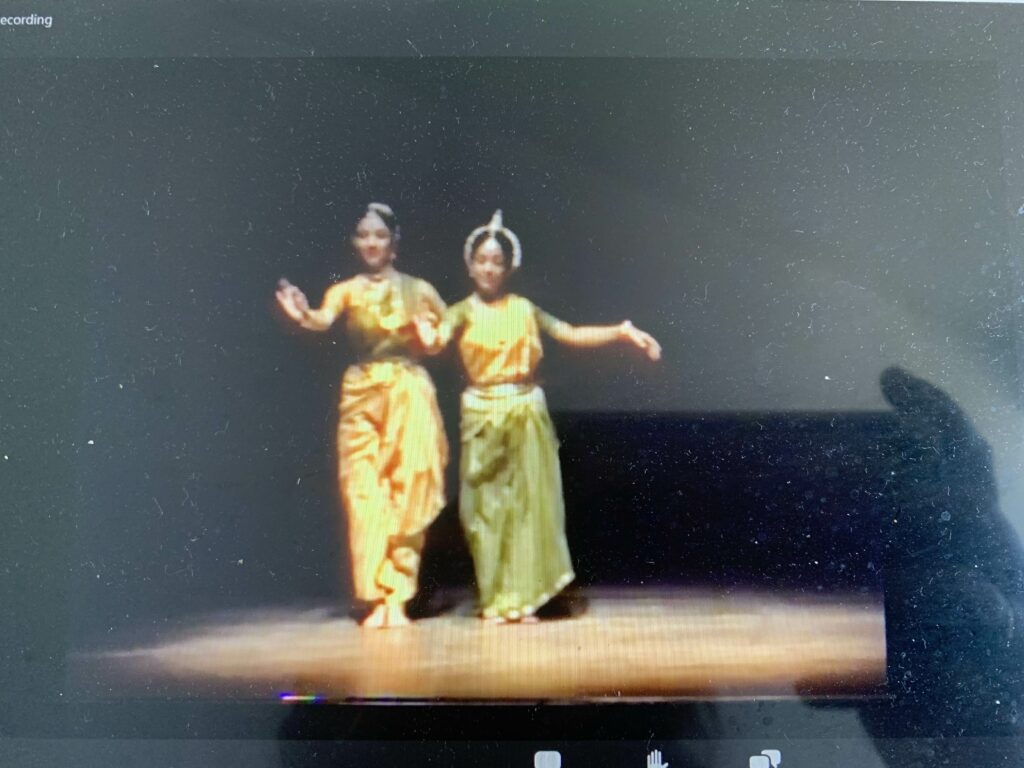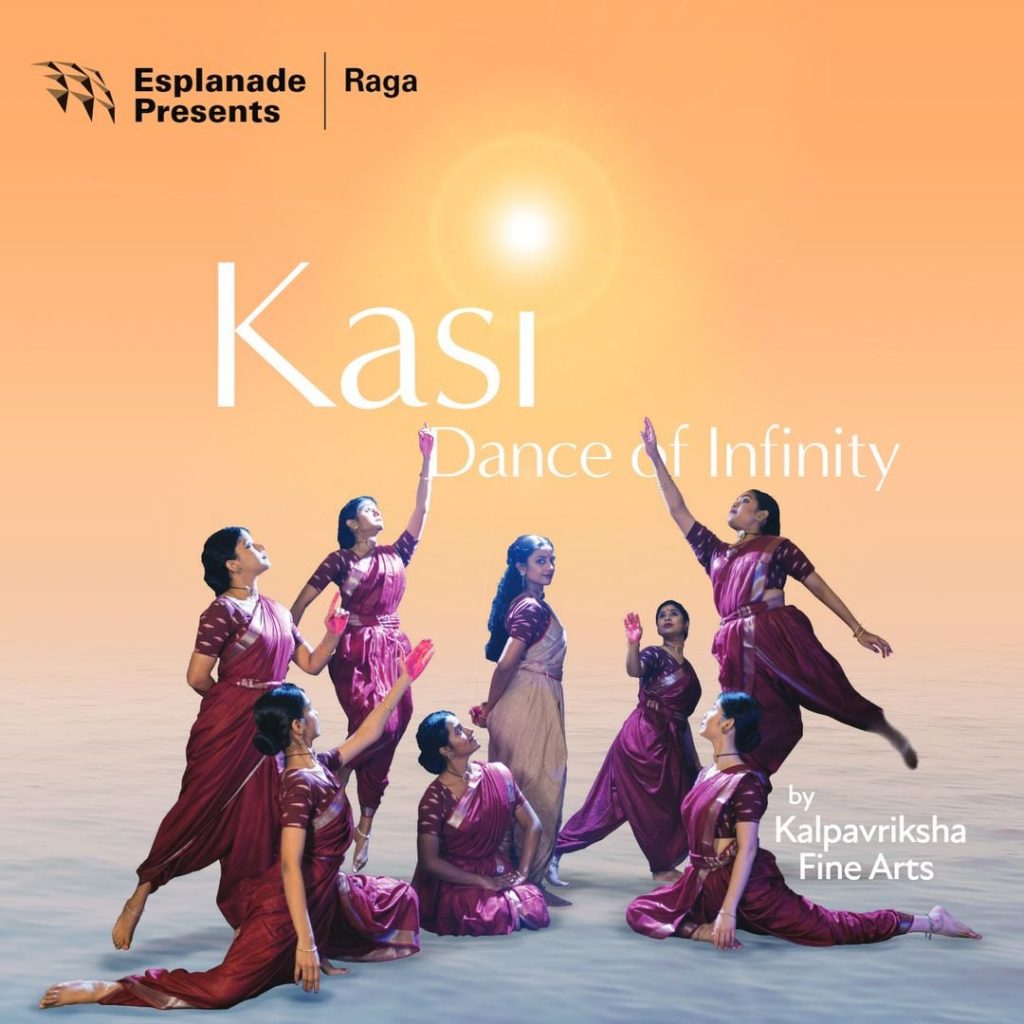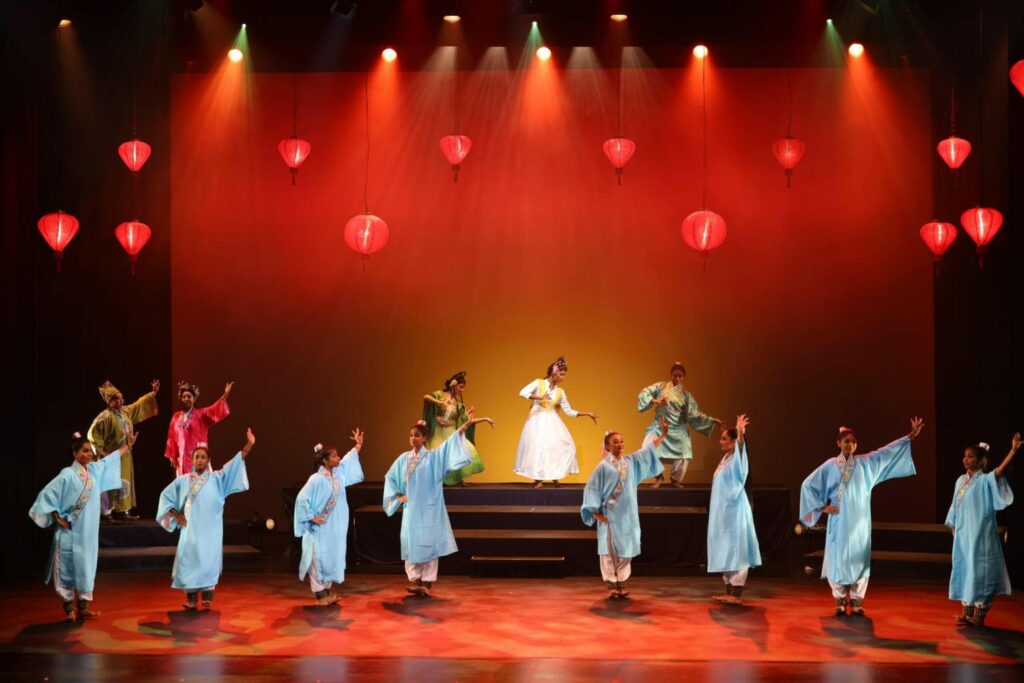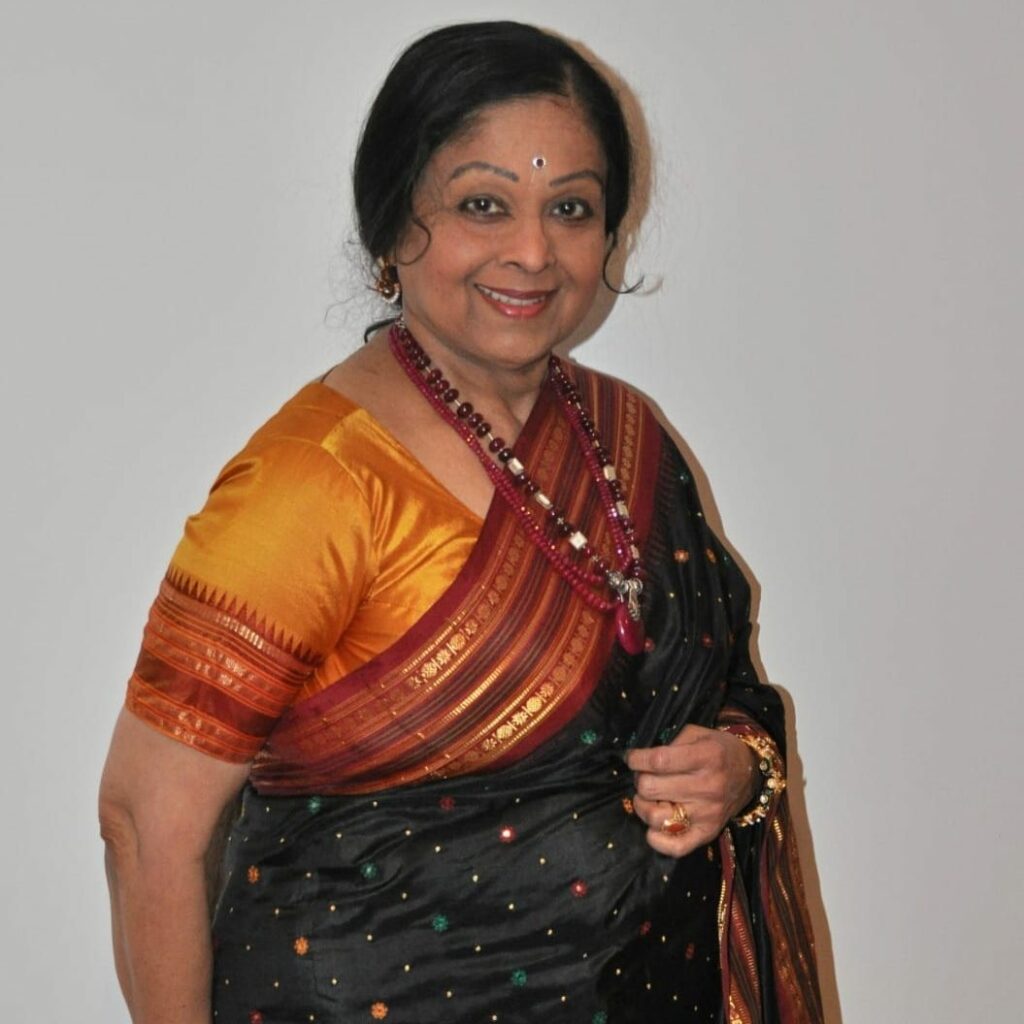Spotlight Series October 2020

In a session entitled “Art of Collaboration” featuring two stalwarts of classical dance – Leela Samson and Madhavi Mudgal, they shared their early interactions in pioneering efforts in the genre of collaborative dance performances. This conversation was guided by Aravinth Kumarasamy who engaged them in an effortless dialogue of memories of their craft and long-held friendship and common goals in their dance journey. They both shared that they first came together in a TV series, where as they performed their dance form’s footwork, a realisation that a common ground could be found. They began work with certain Ragas which helped them explore a collaborative dance. Both reminisced of the fun times they had in 1975-76 in Delhi and Raag Hindolam & Raag Malkauns which opened up these possibilities. Leela akka shared that when collaborating, it was important to find similarities within the natural form of the artform which brings harmony yet allows for appreciation of the differences. She called their collaborative work – a “confluence” of ideas. Madhavi didi spoke about “Sanskriti” – a togetherness where the exploration was not a competition of ideas yet on reflection, this kind of jugalbhandhi had not been done before them. They also spoke about the importance of creating silences within a performance and the importance of staying true to ones’ own dance form and working on finding compatibility. Much credit to their early collaborations was given to Madhup Mudgal (brother of Madhavi didi), acclaimed Hindustani vocalist, who helped them with his compositions especially in the use of Thumris & Khayal and gave them latitude to explore the concept of Abhinaya in Thumri. Madhavi didi spoke of the difficulties of collaboration in the 1970s when they were very much on their own – no funding, handling all aspects of production & negotiating both the creativity and the practical aspects of a show. She noted the tremendous support from vocalist, O S Arun and his willingness to try new ideas. She credits the fact that as young artistes then, their openness to experiment and exploration helped. Reminiscing, Madhavi didi shared the challenges in finding space, the lack of resources for set design & finding affordable yet compatible sarees. Leela akka went on to explain how the “Bols” were negotiated in their collaboration – the precision needed and “journeying into the others’ space.” She emphasised the need to make effort to learn about the other dancer along with the artform without being judgemental and giving mutual respect to both the person and the style. Madhavi didi spoke about the influence of their Gurus who were alive then to critique their collaboration and she explained that their creative process embedded the inputs of musicians – e.g. Shubha Mughal (her niece), a young vocalist then would perform a Thumri in Khayal-style and they would let the singers sing and as choreographers they would listen, imbibe and then create their steps . They both emphasised the importance of retaining the essence of the genre of the music. Another important aspect of choreography included the need to be sensitive to the audience watching as they would need to watch two dancers at the same time, thus many considerations would need to be evaluated when developing a duet. Leela akka put it astutely when she said, “There is no need to make it a “drama” – a duet is not a tennis match. The dancers should come very close yet not be merged together.” In the Q&A segment, there were many questions from dance students. Both artistes shared some key wisdom. They spoke of the importance of lessons in learning of the artform – as students, much is copied yet to become a serious dancer, the need to get deeper into each item happens when working on a collaboration. This kind of initiative helps a dancer realise how much you don’t know and the influence you can have on the other and the long-standing impressions that get created. They advised that in a collaboration, the compatibility of dancers is important. A willingness to compromise, to find a third area of “movement vocabulary” that speaks to each other. The dancer’s attitude towards the other should be based on a mutual understanding, not to be pressurised to do something & to give the collaborative experience – time to flourish. Dancers should have a thirst and quest to work with others. An overarching message from both the artistes is that our Indian dance traditions have certain structures which need to be respected and there is much to create within it. Over 80 participants were present at this engaging and inspiring session.
Review of KASI

Kasi: A Journey Around & Within Kasi – Dance of Infinity was well-researched, layered and inter-woven in its premise and unfolding, writes Swarnavarsha Gurumoorthy Kasi – Dance of Infinity by Kalpavriksha Fine Arts, presented under Esplanade’s Raaga series is a choreographic work of Meera Balasubramanian under the mentorship initiative as part of Apsaras Arts’s Indian Performing Arts Convention (IPAC) Residency program. Under the guidance of renowned dancer Rama Vaidyanathan, Meera Balasubramanian and her team took the audience through the length and breadth of Kasi, referred to as the spiritual capital of India, letting us journey its vibrant and varied landscape. Divided into four acts, each with a flavour of its own, the production was a celebration of the art of detailing – well-researched and interwoven by Meera, who personified the notion of Kasi. The first act, I am Kasi, opened with the depiction of restlessness within one’s mind, effectively portrayed by the ensemble dancers who broke into a vibrant jathi placing themselves in the formation 8 attempting the establish the idea of infinity. The fluidity in the formations ensured that the varying heights of the supporting dancers were barely significant in the Kasi Panchakam that followed. The second act titled I am Avimukta choreographed with graceful movements glorified goddess Annapurna and her generosity. Act Three began with the process of weaving – thoughtfully conveyed using body movements and adavus with appropriate lighting techniques. To bring in an element of love and union, a Thumri was presented by Meera who wore a purple lehenga like a Kathak dancer, accompanied by the dancers enacting a story of two lovers in the background. This act, I am Benaras ended with Meera presenting a Benaras silk garment that brings a couple (means what?) draws parallels to the rivers, Varun and Asi that unite as Varanasi. The final act, I am Mahasmashaana added vigor after the mellifluous Thumri. The entry was marked by three dancers who moved the audience with their soulful devotion and spiritual ecstasy in a complete trance chanting Kaashikaa-Pura-Adhinaatha-Kaalabhairavam Bhaje. Kalabairava considered the Lord of Kashi, also represents time and breaks the cycle of life and death to attain salvation. A Thillana in ragam Nalinakanthi (composed by Sudha Raghuraman) after that vibrant Kalabairava, offered a different perspective of Kasi with a suggestive depiction of the famous Ganga Aarthi. In an attempt to establish the continuous cycle of time, there were no significant pauses between the acts for the audience to absorb certain aspects of the presentation. The simple aaharya (costume) designed by Meera Balasubramanian and minimalist jewellery not only complemented the mood but also helped the cast execute complex movements with ease. Added to this, the well-seasoned ensemble dancers – Akshaya, Maanasa, Roshini, Preethi, Shobana, Shreya and Soo Mei Fei – maintained high energy levels through the five shows across three days. The musical pieces for the production were carefully chosen from the works of Adi Shankara, Swathi Tirunal, Muthusamy Deekshitar and other eminent composers beautifully arranged and sung soulfully by Delhi-based Sudha Raghuram. One felt that the Thumri could have been handled by a Hindustani singer to add that flavour of a Kathak composition. With Kasi, Meera has established herself as an able choreographer who has the ability to translate her vision, on stage.
Review of Butterfly Lovers

A visual delight but not raising the bar, Swarnavarsha Gurumoorthy breaks down Butterfly Lovers for us… Butterfly Lovers at Victoria theatre, co-presented by Bhaskar’s Arts Academy and Singapore Chinese Cultural Centre was a blend of tradition re-visited almost sixty years since it was first staged. Visualised by Santha Bhaskar in the year 1958 and re-envisaged by her daughter, Meenakshy Bhaskar in 2021, this version combined both the Chinese and Indian dance styles. Dating from the Tang Dynasty, the Butterfly legend talks of Zhu Yingtai and Liang Shanbo, whose relationship is delayed when Zhu cross-dresses as a boy to enter school. This obstacle is removed; Zhu’s father arranges her marriage to a wealthy man. Learning of the news, Liang dies, with Zhu following in suicide. The duo is re-incarnated as loving butterflies. The first act set is a perfect ambience for this Chinese Romeo- Juliet with musician Neil Chua’s soulful performance on the ruan (a Chinese instrument). Within the performance, the set design is also crucial to bring the visual experience to the next level. The stage props such as the traditional Chinese lanterns in a few scenes and dangling creepers in others, successfully created an artistic conception for the audience. Another highlight was the three-dimensional effects in the background that further amplified the scenic beauty. In an effort to blend both styles, the dancers in traditional Chinese attires with salangais, attempted some “Indianized Chinese dance movements” which became repetitive after a point. There were some lively moments during Yingtai’s and Shanbo’s school years along with other scholars which engaged the audience and brought some laughter. Malini Bhaskar as Shanbo and her perfect chemistry with Sarenniya Ramathas as Yingtai reflected extensive years of them dancing together. Their apparent confidence in each other as dancers coupled with pirouettes added dynamism in contrast to the amateur supporting characters and dancers. he scene where Shanbo becomes an alcoholic was thoughtfully planned with only the ruan being played to the viraha portrayed by Malini Bhaskar. The choreography for the Thillana performed by the leading duo seemed to have a lot of packed adavus resulting in some unfinished movements. The musical score for this re-visit is by the renowned music composer Rajkumar Bharathi. This combination of alternating Chinese and Indian music hardly resonated with the theme and was ineffective in creating an emotional impact. The Tamil lyrics and dialogues in the presentation lacked depth in terms of poetry and the choice of words. To sum up, Butterfly Lovers was a delight to watch in terms of aesthetic stage settings, creative visuals and the dynamic lead duo in perfect unison with each other. While Sreejith Krishna’s Don Quixote that premiered in 2015 broke new ground in uniting Indian classical dances with contemporary performance and storytelling elements, this choreographic work of a Young Artist Award recipient missed out on setting high standards. Review is by our young dance-critic-in-the-making, Swarnavarsha Gurumoorthy, recipient of Dr Sunil Kothari Dance Journalism Scholarship by Apsaras Arts. DISCLAIMER: The views and opinions expressed in this review are those of the reviewer and do not represent the views and opinions of Apsaras Arts Ltd. All rights reserved.
Spotlight on Mohiniattam

Dr Tara Rajkumar introspects on Mohiniattam then, and now and comments that with aspiring young dancers practising and researching this dance form, Mohiniattam is all set to shine It is now more than half a century since I first delved into the dance art of Mohini, the proverbial Vishnu Maya. The enchanting illusion of Lord Vishnu, all prevailing, is often depicted in Hindu mythology as a powerful beacon of beauty, grace, and enchantment. Mohini then becomes a divine force to reckon with, destroying evil and restoring peace on earth. When defining Mohiniattam the aim of the dancer should be to try and capture at least that desirable element of the Lord and embed it in the dancing and storytelling. Yet, beyond mythology, reality sadly speaks of another truth. Mohiniattam was rather desolate in the immediate post-colonial past. The dance and its practitioners were shamed into disownership and destitution. A cultural resurgence and re-establishment through the 1930s and 1940s all over India took root in Kerala as well. In the deft hands of the visionary poet Mahakavi Vallathol, the Kerala Kalamandalam was established. The revival of Kathakali and the performing arts of Kerala was propagated with care and deep commitment. Mohiniattam too was given a new lease of life. Dominated by Kathakali in its own home and by Bharatanatyam outside it, Mohiniattam languished, and progress was slow in the first few decades. Many of the gurus who choreographed for Mohiniattam were primarily teachers of Bharatanatyam and watered down their advaus to suit the wide stance, soft footwork, and undulating movements central to Mohiniattam. This resulted in a less than exciting and lacklustre repertoire and Mohiniattam was often referred to as the poor cousin of Bharatanatyam. Fortunately, Mohiniattam has gained immensely through the astute, exemplary, and extraordinary work of a few pioneers who have made major inroads and added invaluable facets which have lifted this style as a major Ekahara lasyanga form to emerge from Kerala. For example, the work of Padmabhushan Kanak Rele in the late 1960s and 70s highlighted the strength of abhinaya, the powerful signature of the theatre arts of Kerala arts and its seminal role in realising the potential of Mohiniattam. The genius of Kavalam Narayana Panicker provided a whole new dimension with his emphasis on the Sopana style of music and its bearing on Mohiniattam performances through the expansion of the Mohiniattam repertoire. The pioneering work at the Kerala Kalmandalam was defined by two fine gurus Chinnammuamma and Kalyanikutti Amma. Their parampara/lineage has sustained the Mohiniattam style, its growth and evolution through the decades. Learning Mohiniattam from guru Smt. Kalyanikutti Amma in the mid-1960s was a great blessing for me. Over the decades I have worked hard to build my repertoire with deep research and actively developing choreographies that mirror the growth of the dance style. Every decade is marked by a few additional practitioners who leave their mark on enhancing the dance form. I also had the unique good fortune and opportunity to study the sopana mode of music from the edakka maestro Njaralathu Rama Poduval. My years of intense training in Kathakali, the Kerala tala systems and sopana music and the intrinsic knowledge gained through this experience was invaluable and essential for the evolution and growth of my Mohiniattam repertoire. The leading practitioners emerging from the main schools of Mohiniattam have rich legacies to protect and enhance. Every committed dancer has the responsibility to stay true to pedagogy while at the same time enhancing one’s own performance through theoretical and practical research. The past two years of COVID isolation come with a silver lining. The phenomenal reach through internet technology became the unexpected saviour by linking like-minded artists towards an international awakening and coming together. This is benefitting the performing arts, emerging artists as well as the gurus, and provides a powerful window into the world of Mohiniattam and the Kerala theatre arts. Among the bright, aspiring young dancers, there is a healthy number researching Mohiniattam and working towards their postgraduate degrees. This augurs well for Mohiniattam which is all set to shine. It was 1973, just a year after I came to London, the city which was quite the centre of the arts world. I received a gift parcel from the eminent dance historian and critic, late Padma Shree Dr Sunil Kothari, Sunil Bhai, who had encouraged me in the 1960s in India when I was striving to develop a complete repertoire in the Mohiniattam style. His gift was the March 1973 issue of Marg on Mohiniattam with his message dated 6 July 1973: “To Tara Rajkumar with best wishes and wanting her to take off further from this number and enrich the style further”. My efforts were drawing accolades and starting to find success when I left India for England. The respected dance and music critic Subbudu gave me a memorable send off by putting me on the cover of the well-known Tamil magazine Dinamani Kathir in September 1971. From then, I have never looked back. Presenting and dancing Mohiniattam all over Britain, Europe, and later in Australia, I have had the privilege of growing with the style, adapting and enhancing the presentation for largely non-Indian audiences. I was privileged to start the first schools for Mohiniattam in Britain in the 1970s and Australia in the 1980s. Those were early days with fewer Indian diaspora interested in the classical performing arts. Running a Mohiniattam school in Melbourne with a large number of students from many different ethnic backgrounds and presenting numerous arangetrams were ground-breaking. We worked with a pioneering zeal to take Mohiniattam and Indian performing arts to prestigious festivals and venues across Australasia. Monash Asia Institute, Monash Performing Arts Centre and the Music Department at Monash University allowed me to foster several collaborations and courses. Thirty years on, it is fantastic that the Indian Performing Arts Convention (IPAC) is bringing the performing arts of India to Melbourne and specially at Monash University later this year. The writer, recipient of Medal of